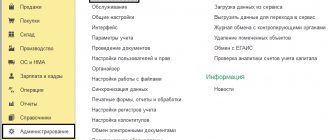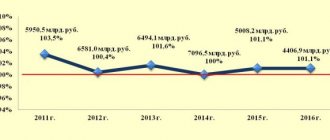Methods of classification and coding of goods
There are only three classification methods:
- hierarchical,
- faceted
- and mixed
The hierarchical method is the sequential division of a set into subordinate subsets.
Hierarchical classification distributes goods from more general to less general characteristics. The subsequent link specifies the previous one. Hierarchical classification is:
- large information capacity,
- ease
- familiarity of use.
The disadvantage of hierarchical classification is the inflexible structure and fixed order of distribution stages. In this classification there is no possibility or reserve capacity for new objects and characteristics. The number of features is a sign of classification depth. Theoretically, it can be infinite, but if you need to increase the number of features, then the facet classification method is used.
The facet classification method is a parallel division of goods into facets (groups independent of each other). The peculiarity of facet classification is that the facets do not obey each other. Each facet is a characteristic of one side (characteristic) of the set.
The advantage of this type of classification is the flexibility of the structure. Changes to any facet do not affect the set. Disadvantages of facet classification:
- insufficient capacity utilization,
- non-standard application,
- difficulty for manual processing of information.
In some cases, both methods are used - a mixed type of classification.
Basic parameters for classifying goods at customs
Customs classification of goods is carried out on the basis of relevant documents. In this case, the classification is usually based on three basic characteristics:
- Name of product;
- product description;
- graphic image of the product.
Note 2
The name of a product can take two main forms - a commercial name or a product name. The latter is also called the product name.
Customs classification of goods is fundamentally based on universal methods of comparing the desired objects with a certain set of classes in the form of their corresponding names. Typically, the searched objects are commercial or product names of goods and/or their description. Classes used in the commodity nomenclature of foreign trade activities are understood as the names of sections, groups and commodity items.
Currently, the commodity nomenclature of foreign trade activities consists of 21 sections, which in total contain 97 product groups (Figure 1).
Figure 1. Structure of a unified foreign economic activity product nomenclature. Author24 - online exchange of student work
The ten-digit code of the product itself, which determines its customs classification, has a certain meaning and can be “read”. The customs code is built according to the decimal system, and the characters that form it vary from 0 to 9.
Every two subsequent digits of the code determine one or another product category. So, the first two digits indicate the product group of the product. The first four digits characterize the product position. The first six digits determine the subposition of the product. The first eight digits of the code reflect the sub-subposition of the product. All ten digits form the complete product code.
What is KTR?
KTU is a systematic list of all goods, works and services that can be purchased in the interests of state and municipal customers. Law 44-FZ refers to the Catalog in Article 23. Part 3 states that based on the names of objects contained in it, a procurement identification code (PIC) is formed. And in part 6 it is established that the procedure for the formation and maintenance of the KTU, as well as the rules for its use, are determined by the Government.
The purpose of the KTRU is to standardize the names and descriptions of procurement objects. This means that in the procurement of any customer in all documents related to the purchase of a certain product, it will be named and described in the same way. Thanks to this, any discrepancies and situations are excluded when the description of the object does not fully indicate what exactly the customer wants to purchase.
Important! The names of catalog items are formed on the basis of OKPD2.
The catalog was introduced so that all customers would describe procurement items using the same template. On the one hand, this simplifies the preparation of procurement documents, and on the other hand, it does not allow the use of additional characteristics that could limit competition.
Descriptions of procurement objects from KTU must be used when creating:
- schedules;
- procurement justification forms;
- notifications and invitations to participate in procurement;
- procurement documents;
- contracts and reports on their execution.
To receive free advice and assistance in bidding, fill out the feedback form or call: 8 (800) 201-12-78
Methodology for identification and classification of goods for customs purposes
Home — Articles
An analysis of materials from judicial practice related to the activities of customs authorities on issues of identification and classification of goods indicates that in some regions, in 70 - 90% of cases, courts make decisions not in favor of customs. The main reason for this situation is the currently accepted classification of goods, which is due to the underdevelopment of the general methodology and identification management mechanism. This requires the development of modern scientifically based methods for identifying and classifying goods, which will ensure the reliability of control of the declared code of the Commodity Nomenclature of Foreign Economic Activity (TN FEA). In addition, the very concept of “identification of goods for customs purposes” causes ambiguous interpretation among all interested parties (experts, participants in foreign economic activity, customs officials, etc.) participating in foreign economic activity. Thus, in the Customs Code of the Customs Union (TC CU), the term “identification” is understood as “a form of customs control, which is carried out by applying seals, stamps, applying digital, alphabetic and other markings, identification marks, affixing stamps, taking samples and samples, descriptions goods and vehicles, drawing up drawings, making large-scale images, photographs, illustrations, using shipping and other documentation.”
However, this definition does not reveal the essence of identification of goods for customs purposes, which precedes the adoption of a legally significant decision - the classification of goods in accordance with the Commodity Nomenclature of Foreign Economic Activity. Since, depending on the HS code, certain government regulation measures are applied to a product - customs tariff, non-tariff, as well as a system of prohibitions and restrictions, such a broad interpretation, in our opinion, is unacceptable.
It is important to note that, despite the extremely high need for the development of theoretical aspects of the identification and classification of goods for customs purposes, these issues have not received sufficient development and remain poorly developed. Approaches to identity management that are based on a deep analysis of the structure of the Commodity Nomenclature of Foreign Economic Activity and the establishment of its relationship with such categories as use value, material composition, consumer properties and usefulness of the product have not received theoretical understanding either. The latter were reflected in the theory of labor value of K. Marx, in the works of neoclassics who developed the theory of marginalism, as well as in the works of modern economists. These works indicate that contradictions in understanding the essence of these categories persist to this day.
The structure of the construction of the Commodity Nomenclature of Foreign Economic Activity is a logical process of dividing the entire classified set in a hierarchical subordination into separate groupings (facets) according to certain criteria. Their quality in the Commodity Nomenclature of Foreign Economic Activity includes: functional purpose (i.e. intended to meet a specific need), material of manufacture (wood, metal, grain, etc.), nature of origin (animal, vegetable, mineral), depth of processing of the product (raw materials) , semi-finished product, finished product), chemical composition, manufacturing technology, etc.
These material characteristics determine the consumer properties of the product and influence the direction of its use (satisfying any specific need). Consequently, the use value of a product as a set of its consumer properties can act as the main sign of identification of a product in the Commodity Nomenclature of Foreign Economic Activity.
This observation by the author allowed us to put forward the hypothesis that the Commodity Nomenclature of Foreign Economic Activity is a list of use values, and the Basic Rules for the Interpretation of the Commodity Nomenclature of Foreign Economic Activity (GPI) help classify newly emerging goods (not having a separate code) into commodity items with related use values. Based on this, identification of goods for customs purposes is the identification of individual characteristics of a product that allow it to be distinguished from competing commodity items in the Commodity Nomenclature of Foreign Economic Activity and indicating its belonging to a certain homogeneous group of goods with related use values.
The continuity of identification and classification of goods for customs purposes presupposes the presence of a special methodology, which includes a set of different methods and approaches. The relationship between the elements that make up the theoretical basis of this methodology is presented in Fig. 1.
The relationship of the elements that form the theoretical basis for the identification and classification of goods in the Commodity Nomenclature of Foreign Economic Activity
Rice. 1
According to the data in Fig. 1 lack of information about the material composition may serve as a basis for the appointment of a customs examination. When conducting an identification examination, exactly those fundamental features that are laid down in the Commodity Nomenclature of Foreign Economic Activity are taken into account. If a product is identified in accordance with the Commodity Nomenclature of Foreign Economic Activity, then the OPI allows one to quickly determine the only place for it in the classification part.
However, the disparate methods of identifying goods used in customs practice have not received theoretical understanding, and therefore the mechanism for managing this process is difficult.
It is obvious that private methods for identifying and classifying individual groups of goods should be developed taking into account the totality of the composition and properties of goods, indicating that they belong to a certain classification group in the Commodity Nomenclature of Foreign Economic Activity.
It is important to note that individual goods that have the same empirical name, but are produced using different technologies or have different chemical compositions, have different consumer properties, and therefore are able to satisfy different needs of society.
For example, butter can be classified depending on its composition in groups 04, 15 and 21 of the Commodity Nomenclature of Foreign Economic Activity, therefore different government regulation instruments are applied to these goods. In this regard, to control the declared code, for example, butter without indicating its composition (presence of milk fat and water), a customs examination is necessary. Practice shows that when commissioning a customs examination and using its results, difficulties arise that do not allow the effective use of these results. In particular, in the absence of a special methodology for posing a question to an expert, the expert report may not contain the information necessary to make a decision on the classification of goods. The lack of a methodology for using (interpreting) the results of an expert’s opinion can negate any of the most complex laboratory tests of a product.
It is obvious that the combination of all methods in the general identification and classification methodology should ensure consistency in their application. For example, insufficient representativeness of the selected sample (sample) for examination or ambiguous interpretation of the term by an expert and a customs official can lead to classification errors that form negative judicial practice of customs authorities.
In this regard, the general methodology for identifying and classifying goods is seen as a set of interrelated methods and techniques. For the practical implementation of this methodology, it is necessary to develop new approaches that allow individual techniques to be integrated into the overall system. The proposed mechanism for managing the identification and classification of goods for customs purposes can be presented in the form of Fig. 2.
Mechanism for managing the identification and classification of goods for customs purposes
Rice. 2
From the given fig. 2 shows that the identity management mechanism can be improved by:
— creation of an electronic database of classification decisions adopted by customs authorities for methodological support of officials monitoring the correct classification of declared goods;
— developing a list of questions posed to the expert regarding the most problematic groups of goods;
— development of methods for sampling and taking samples (samples) of goods for examination for customs purposes;
— creating a set of scientifically based tools (methods, diagrams, algorithms, scripts for computer programs, etc.) for identifying and classifying individual groups of goods;
— development of methodological recommendations for customs officials on the use of customs examination results when monitoring the accuracy of the declared HS code;
— creation of a special training system for customs officials who monitor the authenticity of the declared code, and commodity experts who carry out examinations of goods for customs purposes.
To reduce the risks of unreliable declaration of product codes, the proposed mechanism (see Fig. 2) should be public and accessible both to customs experts and to other (non-state) expert organizations.
A methodological approach to the identification and classification of goods in the Commodity Nomenclature of Foreign Economic Activity, based on identifying the totality of their material composition and consumer properties, can be presented in the form of an algorithm:
1) first you should answer the questions: What is it? What is it made of? What is it used for? Is the product ready for use or does it need some work? Is it part of something or an independently functioning object? Is this a homogeneous product? What role does its packaging play?
If it is necessary to carry out an examination of a product, it is important to pose questions to the expert taking into account the fundamental criteria established in the Commodity Nomenclature of Foreign Economic Activity. Questions must be posed in such a way that the results of the examination can separate competing product items and subitems. It is not necessary, for example, to establish the entire chemical composition of aviation kerosene, since for its classification it is enough to determine only one identification indicator - the flash point, which distinguishes it from other kerosene.
Then you need to familiarize yourself with the table of contents of the Commodity Nomenclature of Foreign Economic Activity and write down the numbers of sections and groups in a row (make a “line”), indicating all the sections and groups where the product may be located (as part of another product, in a mixture, etc.). This “line” of sections and groups must be compiled taking into account the refined social use value of the product as a set of newly identified consumer properties and material composition, and the possible directions of its use must be taken into account;
2) next, you should familiarize yourself with the texts of the notes to sections and groups to make sure whether they contain a categorical directive on the inclusion of the product under study in any specific heading or, conversely, on the exclusion of the product from a given section or group;
3) if the product is heterogeneous, then when classifying it, rules 2b, 3a, 3b, 3c should be consistently applied. The need to use each next rule in the specified series arises only if the content of the previous one is insufficient to make a classification decision;
4) it is important to remember that often several rules are used simultaneously when classifying a product. This does not contradict the procedure for applying the nomenclature of the Harmonized System for Description and Coding of Goods and national classifiers built on its basis;
5) having completed the search for a product item, it is necessary to check whether the selected place for the product under study in the classification part is the only one;
6) when resolving conflicts that arise when determining the level of detail in the Commodity Nomenclature of Foreign Economic Activity at the level of hyphens, levels of only one order should be compared.
Thus, the considered methodological approach makes it possible to develop the customs information, identify and systematize the fundamental material characteristics and properties of goods for customs purposes. This, in turn, allows us to develop complexes of customs tools (methods, schemes, algorithms, scripts for computer programs, etc.), define individual terms for customs purposes, and develop methodological guidelines for customs officials. In addition, this approach can be used to develop customs instruments aimed at protecting the domestic market from the expansion of imported goods that do not meet the declared quality.
Summarizing the above, it should be noted that problems of identification and classification of goods will arise with the same frequency with which new generation goods (modified, obtained on the basis of nanotechnology, etc.) will begin to appear in our country and abroad in subsequent years. This means that the mechanism for managing the identification of goods must be constantly improved to ensure flexibility and adaptation of customs authorities to any current situation. A well-functioning mechanism will improve the quality of preliminary classification decisions, provide declarants with methodological materials for making independent decisions on the classification of goods, reduce the number and improve the quality of customs examinations.
April 2014
Customs clearance
Overcoming administrative barriers when passing customs control of goods containing intellectual property
Export by mail
Electronic document flow during customs operations
Customs control of export and import of cultural property into the Russian Federation
Information customs technologies: electronic declaration, remote release, preliminary information, customs payment card, electronic freight
What does KTU include in 2021?
The card of goods, works, services indicates:
- OKPD2 and name of the procurement object;
- the actual description with specific characteristics (including photographs, sketches, drawings, digital models, specifications, manufacturer, delivery conditions and links to technical regulations);
- the date from which this description must be used;
- prices from completed contracts for the same goods, works, services;
- unit of measurement.
Let's look at an example description:
KTRU position code - 10.20.13.110-00000007, OKPD2 code - 10.20.13.110: Frozen freshwater fish. Units of measurement are kilograms. Characteristics: Type of cutting: semi-gutted carcass. Type of fish - Second, First. The start date of mandatory application is 02/14/2019, the period is unlimited. No prices found from completed contracts.





